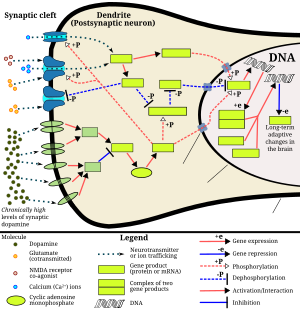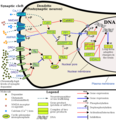File:Annotated ΔFosB.svg screenshot.png
Page contents not supported in other languages.
Tools
Actions
General
In other projects
Appearance

Size of this preview: 580 × 599 pixels. Other resolutions: 232 × 240 pixels | 464 × 480 pixels | 743 × 768 pixels | 1,200 × 1,240 pixels.
Original file (1,200 × 1,240 pixels, file size: 399 KB, MIME type: image/png)
| This is a file from the Wikimedia Commons. Information from its description page there is shown below. Commons is a freely licensed media file repository. You can help. |
Summary
| DescriptionAnnotated ΔFosB.svg screenshot.png |
English: This is a screenshot of the Wikitext-annotated variant of File:ΔFosB.svg as used in the English Wikipedia template en:Template:Psychostimulant addiction, without the notes in the top-right corner. For a description of what the diagram illustrates, follow the preceding link to the English Wikipedia template page. 
|
| Date | 17 April 2015 (the SVG image revision was published on 21 July 2014) |
| Source | Own work |
| Author | Joseph Mickel (Seppi333) |
| Permission (Reusing this file) |
Notice about new image licensing options: As of February 2020, this file has been multi-licensed to more broadly permit the reuse of this image within other media. The original licensing option was the CC-BY-SA-3.0 license. It is now available under all CC-BY-SA licenses as well as the more permissive CC-BY-4.0 license, which does not include the share-alike condition. |
| Other versions | ■ File:ΔFosB.svg – unlabeled version |
| Related image files InfoField | ■ File:ΔFosB accumulation.svg – graphical illustration of how ΔFosB expression changes over time after drug exposure ■ File:TAAR1 Dopamine.svg – schematic illustration of how amphetamine induces the release of dopamine from dopaminergic axon terminals into the synapse via TAAR1 binding and collapsing the vesicular pH-gradient through VMAT2 |
Licensing
| This item is available under multiple licenses. When using it, you can choose which of the following licenses to use. Please make sure you respect the license terms of the license you choose, including any requirements and restrictions (such as attribution requirements and restrictions on commercial use). |

|
Helpful note: Creative Commons Attribution 4.0 International (the first licensing option below) is the most permissive license for republishing this image. None of the licensing options below require you to ask me for permission to republish this file (you already have it) or even notify me before doing so; I'm always happy to learn when/how others reuse media I've created though. |
I, the copyright holder of this work, hereby publish it under the following licenses:
This file is licensed under the Creative Commons Attribution 4.0 International license.
Attribution: you may credit either User:Seppi333 or "Joseph Mickel" in the attribution line.
- You are free:
- to share – to copy, distribute and transmit the work
- to remix – to adapt the work
- Under the following conditions:
- attribution – You must give appropriate credit, provide a link to the license, and indicate if changes were made. You may do so in any reasonable manner, but not in any way that suggests the licensor endorses you or your use.
This file is licensed under the Creative Commons Attribution-Share Alike 4.0 International, 3.0 Unported, 2.5 Generic, 2.0 Generic and 1.0 Generic license.
Attribution: you may credit either User:Seppi333 or "Joseph Mickel" in the attribution line.
- You are free:
- to share – to copy, distribute and transmit the work
- to remix – to adapt the work
- Under the following conditions:
- attribution – You must give appropriate credit, provide a link to the license, and indicate if changes were made. You may do so in any reasonable manner, but not in any way that suggests the licensor endorses you or your use.
- share alike – If you remix, transform, or build upon the material, you must distribute your contributions under the same or compatible license as the original.
You may select the license of your choice.
Captions
en:Template:Psychostimulant addiction
Items portrayed in this file
depicts
17 April 2015
image/png
a1408bd40bce3f5e9206b9e786423e95cfd03bfa
408,516 byte
1,240 pixel
1,200 pixel
File history
Click on a date/time to view the file as it appeared at that time.
| Date/Time | Thumbnail | Dimensions | User | Comment | |
|---|---|---|---|---|---|
| current | 20:27, 9 November 2016 |  | 1,200 × 1,240 (399 KB) | Seppi333 | forgot to remove the notes in the top right corner |
| 20:08, 9 November 2016 |  | 1,200 × 1,240 (409 KB) | Seppi333 | Updated screenshot to reflect recent changes to File:ΔFosB.svg and en:template:Psychostimulant addiction. | |
| 07:31, 17 April 2015 |  | 1,197 × 1,240 (615 KB) | Seppi333 | User created page with UploadWizard |
File usage
No pages on the English Wikipedia use this file (pages on other projects are not listed).
Global file usage
The following other wikis use this file:
- Usage on de.wikipedia.org
- Usage on ko.wikipedia.org
- Usage on pl.wikipedia.org
- Usage on ru.wikipedia.org
- Usage on baike.710302.xyz
Metadata
This file contains additional information, probably added from the digital camera or scanner used to create or digitize it.
If the file has been modified from its original state, some details may not fully reflect the modified file.
| Horizontal resolution | 37.8 dpc |
|---|---|
| Vertical resolution | 37.8 dpc |
